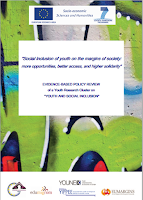Ziel der Studie „Soziale Integration von jungen Menschen am Rande der Gesellschaft: Mehr Möglichkeiten, bessere Zugänge und größere Solidarität“ war es, einen Überblick über die Gründe für prekäre Lebenslagen von Kindern und Jugendlichen und forschungsbasierte Empfehlungen zu geben. Die Studie fächert das Problemfeld differenziert auf. Dabei fand man offenbar entsprechende bzw. bestätigende Befunde quer durch die EU. Auch wenn die Politik, Bildungs- und Beschäftigungssysteme sowie Zuständigkeiten in den jeweiligen Ländern voneinander abweichen, bleiben unterm Strich die Gründe für prekäre Lebenslagen gleich.
Die politischen Maßnahmen, die Abhilfe schaffen könnten, sind bescheiden. Grundlage der Studie, die im Auftrag der Europäischen Kommission von Prof. Dagmar Kutsar aus Estland und Prof. Helena Heleva aus Finnland durchgeführt wurde, waren fünf große empirische Untersuchungen, die in den letzten Jahren erstellt wurden.
Das Hauptmanko besteht nach Meinmung der Studienautoren in mangelnden institutionellen und strukturellen Hilfen:
- ausgrenzende Arbeitsmärkte,
- nebeneinander herlaufende Bildungs- und Migrationspolitiken,
- unterentwickelte zivilgesellschaftliche Strukturen,
- und nicht zuletzt fehlende Übergänge zwischen Wohlfahrtsleistungen, Bildungssystem und Arbeitsmarktpolitik
MORE ...
Social inclusion of youth on the margins of society: more opportunities, better access and higher solidarity.Policy review of the Youth Research Cluster on Social Inclusion (2012) PDF, 1,19 MB.
19.4.12 [Letzte Aktualisierung 31.10.12] Das Vorarlberger Bloghaus verlinkt interessante Weblogs.
CONTENTS
CONTENTSEXECUTIVE SUMMARY
EXECUTIVE SUMMARY
SETTING THE SCENE
The research projects
Chapter 1. THE EUROPEAN YOUTH POLICY CONTEXT
1.1. The European Union
1.2. The Europe 2020 strategy
1.3. The Council of Europe
1.4. The national policy contexts in Europe: notes from the projects
Chapter 1: Key messages...
Chapter 2. BLINDING EVIDENCE: MISSING LINKS AND GAPS IN KNOWLEDGE BUILDING AND YOUTH
POLICIES
2.1. THE POLICY ISSUE: Lack of statistics and political recognition.....
The policy challenge: Recognition in policies and reflexive policy making
Policy implications: Social monitoring and comparative statistics
Recommendations
2.2. THE POLICY ISSUE: Missing links and contradictory policy approaches
The policy challenge: Improve the links between different policy sectors
Policy implications: Multi-agency approach in supporting youth
Recommendations
2.3. THE POLICY ISSUE: Excluding age policies
The policy challenge: Political recognition of the specific needs of young people irrespective of
age thresholds and restrictions
Policy implications: Limits revisited – diversified age politics
Recommendations
Chapter 2: Key messages
Chapter 3. BAD STARTING CONDITIONS: CARRYING ADULTS’ BURDENS AND RESPONSIBILITIES
3.1. THE POLICY ISSUE: Low coping capacities and social capital of families of origin
The policy challenge: External support that complements or compensates for poor family efforts
Policy implications: Early intervention and targeted services
Recommendations
3.2. THE POLICY ISSUE: Poor cultural integration of migrant and ethnic minority youth
The policy challenge: Empowerment of the neighbourhood
Policy implications: Multiple learning options in the neighbourhood
Recommendations
Chapter 3: Key messages...
Chapter 4. EDUCATION – POTENTIAL FOR INCLUSION
4.1. THE POLICY ISSUE: Limited access to pre-school education
The policy challenge: Multiple use of involvement in pre-school education
Policy implications: Wider access to pre-school

Keine Kommentare:
Kommentar veröffentlichen